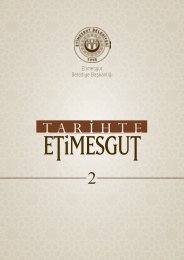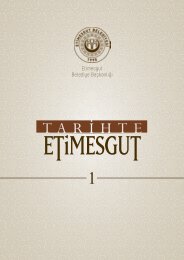BİLDİRİ ÖZETLERİ / ABSTRACT BOOK
Create successful ePaper yourself
Turn your PDF publications into a flip-book with our unique Google optimized e-Paper software.
Uluslararası Tarihte Etimesgut Sempozyumu (UTES)<br />
DEVLET İNŞASI SÜRECİNDE YENİ BAŞKENT YAPILANDIRILMASI<br />
ÖRNEĞİ: ANKARA VE ETİMESGUT<br />
Didem EKİNCİ<br />
Doç. Dr. Çankaya Üniversitesi, Ankara<br />
ÖZET<br />
Tarih, barışta ve savaş sonrası yeniden yapılandırma dönemlerinde birçok devletin,<br />
değişken başarı düzeyleri ile tecrübe ettiği yapılandırma girişimleri ile doludur. Türkiye<br />
Cumhuriyeti de kurulmasından hemen sonra yalnızca yeni bir başkent imar etmekle değil, bu<br />
başkentin çevresinde planlı yerleşim alanları kurmak meselesiyle de ilgili çalışmalar<br />
başlatmıştır. Yapılaşma kent içinde devam ederken, bazı kentler dışında yeni anlayışla<br />
başlatılan numune köy projeleri de bu döneme izini bırakmış olgulardır. Bulgaristan’dan gelen<br />
mübadillerin yerleştirilmesi için projelendirilen Ahi Mesud (Etimesgut) Numune Köyü,<br />
1920’lerin sonu gibi oldukça erken bir tarihte hayata geçirildiği dikkate alınırsa, genç<br />
cumhuriyetin kalkınma ve yapılandırma öngörüsünün ne derece kapsamlı ve o dönemin kent<br />
yapılandırma anlayışıyla eşit önem atfedilen bir düzeyde olduğunu ortaya koymaktadır. Bu<br />
çerçevede bu çalışmada, Ankara’nın savaş sonrası yeniden inşası ve başkent oluşunun altyapısı<br />
ele alınmakta ve planlı kırsal yerleşim yerleri bağlamında numune köyler olgusu çerçevesinde<br />
Etimesgut örneği üzerinde durulmaktadır. Son tahlilde, hayata geçirildiği yıllarda uzun erimli<br />
olması amaçlanan bu planlı köy yerleşimi örneğinin zaman içinde orijinal yapısını yitirmiş<br />
olmasına karşın, savaş sonrası devlet inşasında sivil alandaki girişimler bakımından daima<br />
anılacak bir örnek olduğunu ifade etmek yanlış olmayacaktır.<br />
Anahtar Kelimeler: devlet inşası, Etimesgut, numune köy, yapılandırma<br />
<strong>ABSTRACT</strong><br />
History is replete with construction attempts of many states during peace and post-war<br />
reconstruction periods, resulting in various levels of success. Soon after its establishment, the<br />
Republic of Turkey launched efforts not only to build a new capital city but also to construct<br />
planned settlement areas. While construction continued in the cities, new model village<br />
projects that were launched in the outer skirts of some cities left their trace in the period<br />
concerned. Planned for the settlement of the Turkish emigrants from Bulgaria at a quite early<br />
time as the 1920s, the model village of Ahi Mesud (Etimesgut), demonstrates the new<br />
republic’s understanding of development and construction as well as the equal importance<br />
attached to villages in relation to city construction. In this framework, this paper provides a<br />
brief background on post-war reconstruction of Ankara and its declaration as capital city, and<br />
highlights the case of Etimesgut in the context of the planned settlement areas and the model<br />
village concept. In the final analysis, it is stated that the case of Etimesgut constitutes a model<br />
which is likely to be always referred to in terms of civilian post-war Turkish state building<br />
attempts despite the fact that the model village lost its original structure in the course of time.<br />
Keywords: state building, Etimesgut, model village, construction<br />
169






